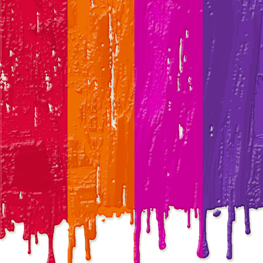
Don’t think that just because you aren’t artistic, you can’t teach your children about art. That’s like saying you can’t teach your kids to eat - all you really need to do is supply the food (and maybe a fork or spoon) and they’ll do the rest. With art history, theory and technique, the recipe is to present your home schoolers with a mix of information, examples and tools to explore and to express themselves. Let ’em get their synthetic bristle brushes wet at home.
Think about it: Stringing macaroni necklaces is not that different from ancient bead-making, potato prints resembling Matisse’s serigraphs and certainly you’ve cocked your head at a Jackson Pollock and proclaimed, “My kid could do that!”
Yes, that’s exactly the point. Fortunately, home educators have access to hundreds of free resources to help teachers teach.
Lessons at the library. Your local library is an obvious resource for books and audio-visual materials about the arts. Hardback books filled with full-color prints can be pricey, so borrowing is a better deal than buying. If your child has a real interest or favorite artist, keep an eye out for discount bargain tables and yard sales. Additionally, many Calgary library branches offer programs beyond simple drop-in crafts. Local artists share their knowledge and enthusiasm with children of all ages. Learn the process of an animation flipbook. Make a beaded necklace or bracelet. Use recycled materials to create eco-friendly art.
Endless online options. Type ‘art lessons’ into your search engine and you’re set. Cull through the endless options to find lessons and activities that engage your children and suit whatever academic goals you may have set. Sites such as KidsArt, KinderArt, HotChalk and even about.com provide your artistic springboard.
If you’re looking for step-by-step, how-to-draw instructions, you can find hundreds. Many lessons start with basic shapes that can lead to geometric studies. Realistic painting comes from observing an object’s nuances. Initially, a child may say an apple is red. But when you really look at the fruit, you’ll notice many different shades and colors. The ability to ‘see’ is an important lifelong skill worth developing, even if you never use it to paint.
As much as I endorse ‘art for art’s sake,’ I prefer to intertwine some history and theory into our hands-on lessons. To learn about the Dada movement, one site suggests contrasting and comparing Leonardo da Vinci’s familiar Mona Lisa with Marcel Duchamp’s Mona Lisa sporting a moustache and beard. Research and discuss the influence that World War I had on the Frenchman. Then pick another famous piece of art and ‘Dada’ it up.
Art as curriculum crossover. Even for younger children, always look for a catalyst to other, perhaps more challenging or dry, topics to engage your student through art. One quick and easy project that even my art teacher used over 40 years ago is the Cursive Name Bug/Butterfly Craft.It incorporates penmanship, science and art in one pen stroke. Along with cursive writing practice, the activity illustrates symmetry and opens up scientific discussion/exploration about what is/isn’t symmetrical and why.
Materials
Large sheet of white construction or watercolor paper
Pencil
Black crayon
Water-based paints/brushes, markers and/or crayons
Safety scissors
Water-based glue
Large sheet of black or colored construction paper
Optional: Additional decorating materials like glitter or foam shapes
Steps
Fold white construction paper in half, lengthwise.
Use pencil to write the name in cursive along the crease of the paper. Make sure the letters are large, connected and flowing.
Trace over name several times with black crayon to thicken/darken.
Refold the paper and rub it until the name appears (in black crayon) as a mirror image on the other half of the paper.
Unfold the paper and retrace both sides with black crayon until they appear dark/same value.
With paints, markers and/or crayons, color inside the letters, using the same color on each side of a letter to create a mirrored or symmetrical appearance.
Cut out the name, leaving a small white edge surrounding it, creating a bug or butterfly.
Glue the colorful creature to the black or colored construction paper. Decorate, if desired. Great for a wall or bedroom door plaque.
With some online searching and a trip to the library, you can find art projects, history and theory for your creative child from tot to teen. The real education comes when you integrate other subjects into the activity making learning seamless and fun. Who says you can’t teach art?
Susan home educated her son for 12 years through high school graduation. She lives near the Mid-Atlantic Ocean and is on permanent creative sabbatical.
Calgary’s Child Magazine © 2024 Calgary’s Child